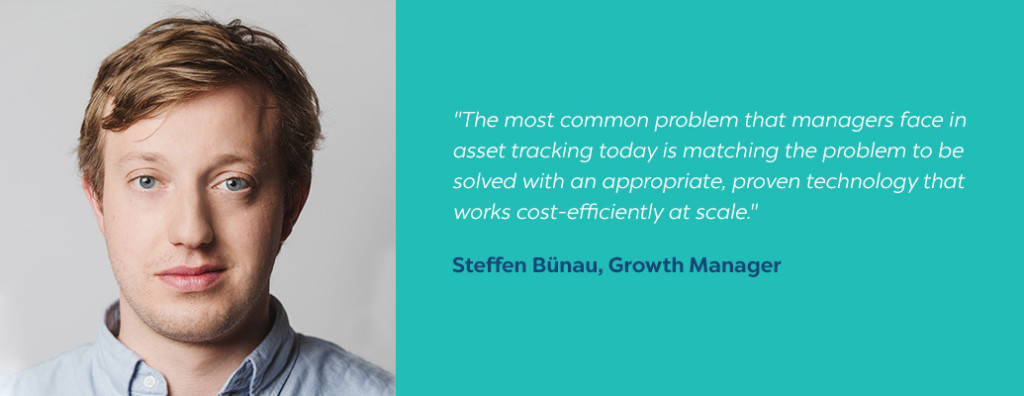"The area of most excitement is industrial where low-cost, high accuracy beacons can be a fraction of the cost of other RTLS/asset tracking solutions. 2017 will be the year of proving that these technologies can scale."
Patrick Connolly, Principal Analyst at ABI Research
That's why Kontakt.io is taking the reigns on Bluetooth-based asset tracking. Our upcoming Location Engine Webinar will help managers understand beacon technology, from API to triggers to streaming to data, and learn how to leverage beacons to optimize RTLS and business models.
Understand the Technology
Understanding what’s happening behind the scenes is just as important as implementing a shiny new business model. That’s why we’re going to show you exactly what the Location Engine can do including the brand new Trigger capabilities that allow your beacons to be far more active, longer-lasting, and effective.
- Leverage the API
- Implement Triggers
- Use analytics (dwell time, connections, presence)
- Websocket and data streaming: live demo

Put Data to Use in Your RTLS
Beacon data is popularly used by retailers and in-store advertisers, but that is far from its only usage. Asset tracking benefits greatly from timely information and a clear image of how objects in a space move both historically and in real time. That’s why beacon data is especially powerful for RTLS.
We’ll show you how to use the Kontakt.io API and cover both static analytics and real-time location tracking.

How Can Businesses Make the Most of their RTLS?
RFID, WiFi, and Bluetooth all power great RTLS systems. So what makes Bluetooth different? We know that, for zonal tracking, Bluetooth offers the same value for nearly 1/5th the cost of competing technologies. We know it is easy to scale and can be infinitely easier to manage than short-battery-life WiFi tags or active RFID with huge antennae.
This webinar will help you understand:
- What scenarios make good business for beacons
- How to evaluate ROI proposition
- How zonal tracking can enhance your business
Interview with Steffen Bünau
We sat down with Steffen Bünau, who will be heading the business portion of the webinar, to gather some insight into how businesses can prepare to implement the best RTLS system for their particular company.

How can I measure success in an asset tracking system or know what areas to optimize?
Despite cool features and interactive maps and graphs, asset tracking systems cannot increase revenue or decrease costs or business risks in and of themselves.
Common commercially successful applications typically fall into one of the following groups--but that is not to say more creative or advanced use cases don’t exist, as we are fully convinced of the creativity of our partners.
Cost reducing: Typically, this comes down to making more efficient use of equipment or space. Think about a widely spread out patient base in a hospital. Not only does that increase the time for doctors and nurses to visit and care for each patient but it will also drive up ancillary costs like heating. At the same time, discovering under-utilized assets like wheelchairs can free up money for more effective patient care.
Revenue increasing: Even in today’s high-tech world, it is often unclear what exactly people do within a typical production environment. A current case I am working on focuses on understanding what can be done to support workers to be more productive, spending less time in unfulfilling and non-productive tasks like locating the right tools and materials for a given task. By enabling the workforce to be more productive, asset tracking can help increase output and ultimately revenue.
In both cases, a successful project will have at least one element of monetary benefits that can be measured. Additionally, it is important to understand and highlight additional benefits such as increased transparency and a culture of innovation brought about by using new technologies.
Regulatory and other risk management: Both access control and health and safety risks are growing concerns that have traditionally been expensive to handle. Using Bluetooth card tags carried by staff allows for safe and efficient monitoring of security-controlled areas as well as alerting health and safety professionals in risky environment.
What does every manager need to know before setting up or modifying their asset tracking system?
A basic overview of the existing technologies, either through our RTLS white paper or the book "RTLS for Dummies" which also provides the basics of different technologies.
Secondly, when moving beyond an education stage, the most important element is to understand the problem you are solving. Ideally, expressing the problem as a metric, for example "We need to increase equipment utilisation by 15% until Q2 2017.”
Once you have defined the problem and understand the associated budget, try to talk to one solution provider from each technology. For example, Infsoft for UWB, Kontakt.io for Bluetooth, AeroScout for WiFi based solutions.
What are the most common problems managers must face in modern asset tracking?
As with any investment, managers need to deliver a solid ROI with their asset tracking or asset positioning system. From our perspective, this breaks down into to two core elements: a) the value of the problem to be solved and b) the technology to solve this problem with.
From ultra-sound, to active RFID, to Bluetooth Low Energy, managers face a myriad of technology choices with large underlying differences. This is further complicated by different concepts from angle-of-arrival to received signal strength indication or time of flight.
For management, these technology choices result in widely varying infrastructure investment, maintenance costs, and operational requirements which affect the ROI. At the same time, managers face an avalanche of new technologies and “cool features” that draw attention but often fail to deliver the required returns beyond an initial proof of concept.
Therefore, the most common problem that managers face in asset tracking today is matching the problem to be solved with an appropriate, proven technology that works cost-efficiently at scale.
